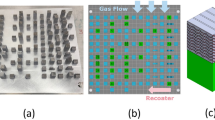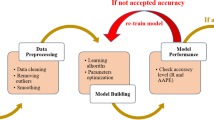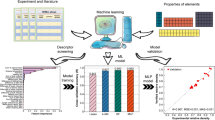Abstract
In the past few decades, computer-aided techniques (i.e., numerical simulation) have complemented the research and development process (R&D) in material sciences. This approach is usually paired to experimental testing. Yet, both techniques have shown cost-efficiency disadvantages and are time consuming. Optimization algorithms like the ones used in machine learning have proven to be an alternative tool when dealing with lots of data and finding a solution. While the use of machine learning is a well-established technique in other research fields, its application in material science is relatively new. Material informatics provide a new approach to analyse materials such as porous metals by employing previous data sets. This article aims to study reliability to predict permeability and Forchheimers coefficient of lost carbonate sintering open-cell porous metal. The key features selected as predictors are porosity, pore size, and coordination number. A comparison among multiple linear regression, polynomial regression, random forest regressor and artificial neural network is revised.








Similar content being viewed by others
References
B.D. Conduit, N.G. Jones, H.J. Stone, and G.J. Conduit, Scr. Mater. 146, 82. (2018).
K. Matouš, M.G.D. Geers, V.G. Kouznetsova, and A. Gillman, J. Comput. Phys. 330, 192. (2017).
T. Lookman, P.V. Balachandran, D. Xue, J. Hogden, and J. Theiler, Curr. Opin. Solid State Mater. Sci. 21, 121. (2017).
J.H. Panchal, S.R. Kalidindi, D.L. McDowell, and C.A.D. Comput, Aided Des. 45, 4. (2013).
A. Gupta, A. Cecen, S. Goyal, A.K. Singh, and S.R. Kalidindi, Acta Mater. 91, 239. (2015).
K. Rajan, Mater. Today 8, 38 (2005).
J.M. Rondinelli, N.A. Benedek, D.E. Freedman, A. Kavner, E.E. Rodriguez, E.S. Toberer, and L. W. Martin, Am. Ceram. Soc. Bull. 92, 14. (2013).
B. Meredig, Curr. Opin. Solid State Mater. Sci. 21, 159. (2017).
A. Agrawal and A. Choudhary, APL Mater. 4, 053208. (2016).
L. Himanen, A. Geurts, A. S. Foster, and P. Rinke, Adv. Sci. 6, 1900808. (2019).
A. Çeçen, T. Fast, E.C. Kumbur, and S.R. Kalidindi, J. Power Sources 245, 144. (2014).
G. Tapia, A.H. Elwany, and H. Sang, Addit. Manuf. 12, 282. (2016).
M. Khanzadeh, S. Chowdhury, M. Marufuzzaman, M.A. Tschopp, and L. Bian, J. Manuf. Syst. 47, 69. (2018).
M. Pardakhti, E. Moharreri, D. Wanik, S.L. Suib, R. Srivastava, and A.C.S. Comb, Sci. 19, 640. (2017).
A.J. Skinner, and J.Q. Broughton, Model. Simul. Mater. Sci. Eng. 3, 371. (1995).
M. Dudzik and A.M. Strȩk, Math. Probl. Eng. 2020, 1. (2020).
S. Altarazi, M. Ammouri, and A. Hijazi, Comput. Mater. Sci. 153, 1. (2018).
Z. Xiao, and Y. Zhao, J. Mater. Res. 28, 2545. (2013).
J.M. Baloyo and Y. Zhao, MRS Proc. 1779, 39. (2015).
E. Avalos-Gauna, Numerical Simulation of Active Cooling Using Porous Metals, PhD Thesis, (University of Liverpool, 2017), pp. 126-187.
E. Avalos Gauna and Y. Zhao, Metall. Mater. Trans. B (2017).
W. Lu, R. Xiao, J. Yang, H. Li, and W. Zhang, J. Mater. 3, 191. (2017).
S. Raschka, Python machine learning, 1st edn. (Packt Publishing, Birmingham, 2015), pp 110–111.
S.S. Skiena, The data science design manual, 1st edn. (Springer, 2017), pp 103–104.
H. Ohno, Appl. Soft Comput. J. 46, 17. (2016).
E. Bélisle, Z. Huang, S. Le Digabel, and A.E. Gheribi, Comput. Mater. Sci. 98, 170. (2015).
Y. Zhao, J. Powder Metall. Min. 02, 2. (2013).
J. Banhart, Prog. Mater. Sci. 46, 559. (2001).
Ö. Baǧci, M. Özdemir, and N. Dukhan, Transp. Porous Media 104, 501. (2014).
J. M. Baloyo, Porous Metals with Novel Structures for Optimum Heat Exchange Performance, PhD Thesis, (University of Liverpool, 2016), pp. 21–33.
M. Faiz, Comparison of Porous Media Permeability: Experimental, Analytical and Numerical Methods, PhD Thesis, (Loughborough University, 2014), pp. 7–34.
J. Despois, and A. Mortensen, Acta Mater. 53, 1381. (2005).
C. Xin, Z. Rao, X. You, Z. Song, and D. Han, Energy Convers. Manag. 78, 1. (2014).
D. Forsyth, Probability and statistics for computer science, 1st edn. (Springer International Publishing, UK, 2018), pp 308–313.
M. Bowles, Machine learning in python, essential techniques for predictive analysis, 10th edn. (John Wiley & Sons Inc, Indianapolis, IN, 2015), pp 211–253.
C.M. Bishop, Pattern recognition and machine learning, 9th edn. (Springer, New York, 2006), pp 663–665.
N. Artrith, and A. Urban, Comput. Mater. Sci. 114, 135. (2016).
T.M. Ahmed, P.L. Green, and H.A. Khalid, Road Mater. Pavement Des. 18, 141. (2017).
H. Chiroma, S. Abdulkareem, and A. Gital, Proc. Int. I, 10. (2014).
Author information
Authors and Affiliations
Corresponding author
Ethics declarations
Conflict of interest
The authors declare that they have no conflict of interest.
Additional information
Publisher's Note
Springer Nature remains neutral with regard to jurisdictional claims in published maps and institutional affiliations.
Rights and permissions
About this article
Cite this article
Avalos-Gauna, E., Zhao, Y., Palafox, L. et al. Porous Metal Properties Analysis: A Machine Learning Approach. JOM 73, 2039–2049 (2021). https://doi.org/10.1007/s11837-021-04695-x
Received:
Accepted:
Published:
Issue Date:
DOI: https://doi.org/10.1007/s11837-021-04695-x




